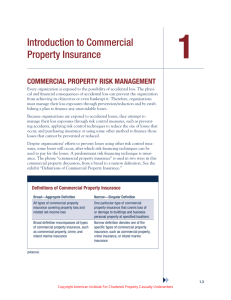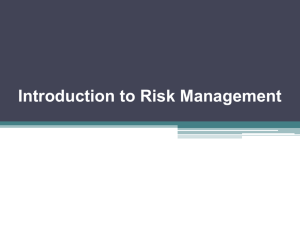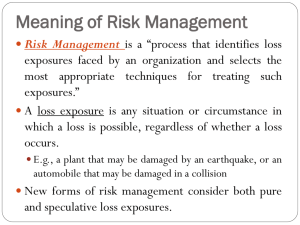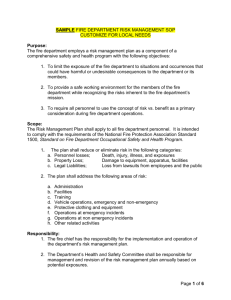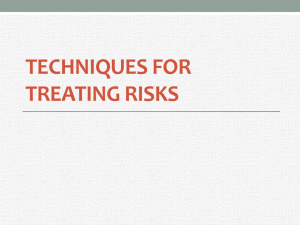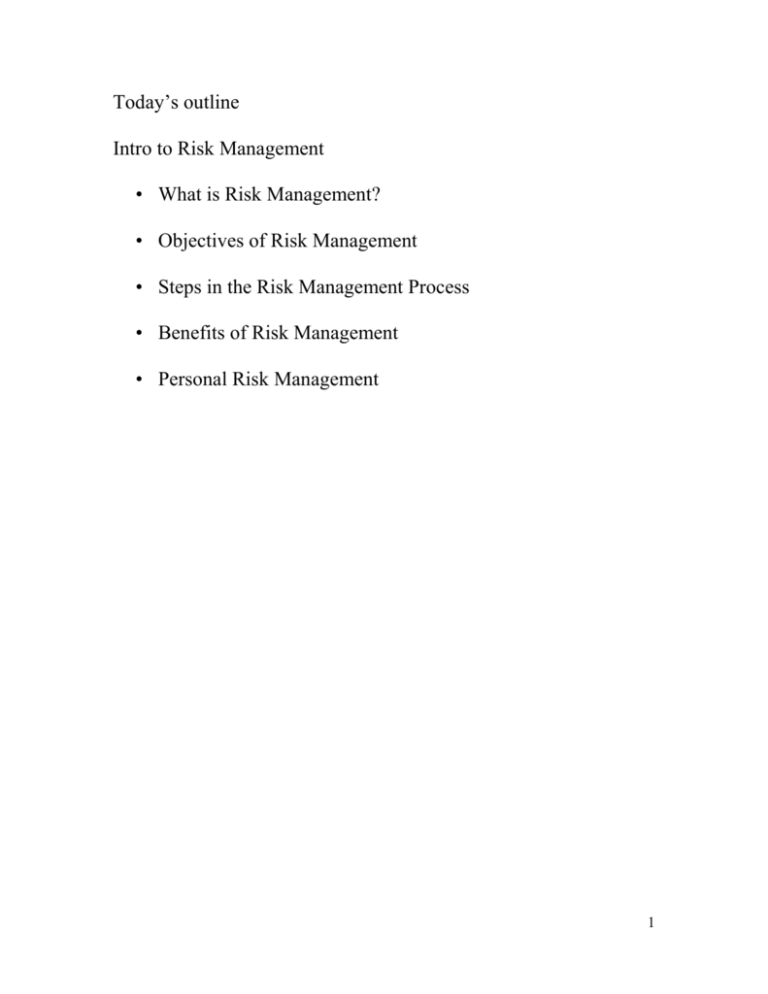
Today’s outline
Intro to Risk Management
• What is Risk Management?
• Objectives of Risk Management
• Steps in the Risk Management Process
• Benefits of Risk Management
• Personal Risk Management
1
In this chapter we begin to understand how individuals and
companies manage risk and that insurance is one of several
ways to finance the costs of risk.
What is Risk Management?
•Risk
Management -a process that identifies loss exposures faced
by an organization and selects the most appropriate techniques for
treating such exposures
loss exposure - any situation or circumstance in which a loss
is possible, regardless of whether a loss occurs
•
Note : New forms of risk management consider both pure and
speculative loss exposures
Recall: Pure loss exposure results in loss or not
With speculative loss exposure profit or loss is possible.
Objectives of Risk Management
Note: Risk management has objectives before (Pre-) and after
(Post-) a loss occurs
2
Pre-loss objectives:
–Prepare for potential losses in the most economical way
–Reduce anxiety
–Meet any legal obligations
•Post-loss objectives:
–Ensure survival of the firm
- loss can’t wipe you off the map
–Continue operations
- The ability to resume at least partial operation after loss
–Stabilize earnings (earnings per share)
–Maintain growth
–Minimize the effects that a loss will have on other persons
and on society
Ex:
3
Exhibit 3.1 Steps in the Risk
Management Process
Copyright © 2008 Pearson Addison-Wesley. All rights reserved.
3-7
4
Identifying Loss Exposures
•Property
loss exposures
•Liability
loss exposures
•Business
income loss exposures
•Human
•Crime
resources loss exposures
loss exposures
•Employee
•Foreign
benefit loss exposures
loss exposures
•Market
reputation and public image of company
•Failure
to comply with government rules and regulations
Risk Managers have several sources of information to identify
loss exposures:
Note: Industry trends and market changes can create new loss
exposures.
Ex:
5
Analyzing Loss Exposures
•Estimate the frequency and severity of loss for each type of
loss exposure
Loss frequency refers to the probable number of losses
that may occur during some given time period
–
Loss severity refers to the probable size of the losses
that may occur
–
Note: Once loss exposures are analyzed, they can be ranked
according to their relative importance
Also note: Loss severity is more important than loss frequency:
Why?
The maximum possible loss is the worst loss that could
happen to the firm during its lifetime
–
The maximum probable loss is the worst loss that is likely to
happen
–
6
Select the Appropriate Technique for Treating Loss Exposures
Note: Risk managers actually select the appropriate technique or
combo of techniques
2 Types of Techniques for Treating Loss Exposure
1) control the risk → use techniques that reduce loss
frequency or severity
2) finance the risk → techniques that provide for the
funding of a loss
•Risk control - techniques that reduce the frequency and severity of
losses
•Methods of risk control include:
- Avoidance
- Loss prevention
- Loss reduction
–Avoidance - make sure certain loss exposure is never
acquired, or an existing loss exposure is abandoned
•The
chance of loss is reduced to zero
•It is not always possible, or practical, to avoid all
losses
7
–Loss prevention - measures that reduce the frequency of a
particular loss
•Ex: installing safety features on hazardous products
–Loss reduction - measures that reduce the severity of a loss
after it occurs
•Ex: installing an automatic sprinkler system
•Risk financing - techniques that provide for the funding of losses
•Methods of risk financing include:
–Retention
–Non-insurance Transfers
–Commercial Insurance
1. Retention - the firm retains part or all of the losses that can
result from a given loss
–Retention
is effectively used when:
No other method of treatment is available
•
The worst possible loss is not serious
•
Losses are highly predictable
•
Ex:
8
Note: The retention level is the dollar amount of losses that the
firm will retain
Also note: A financially strong firm can have a higher retention
level than a financially weak firm
The maximum retention may be calculated as a percentage of the
firm’s net working capital (NWC)
If the risk manager uses retention as a method to finance the risk,
how should the company pay for retained losses?
•Current net income: losses are treated as current expenses
•Unfunded
reserve: losses are deducted from a bookkeeping
account
•Funded
•Credit
reserve: losses are deducted from a liquid fund
line: funds are borrowed to pay losses as they occur
•A
captive insurer is an insurer owned by a parent firm for
the purpose of insuring the parent firm’s loss exposures
- Many captives are located in the Caribbean because
the regulatory environment is favorable
Why do firms form captive insurers?
•The parent firm may have difficulty obtaining insurance
•Costs may be lower than purchasing commercial insurance
•A captive insurer has easier access to a reinsurer
•A captive insurer can become a source of profit
•Premiums paid to a captive may be tax-deductible under
certain conditions.
9
Exhibit 3.2 Growth in Captives
Over the Past Two Decades
Copyright © 2008 Pearson Addison-Wesley. All rights reserved.
3-18
10
• Self-insurance is a special form of planned retention
– Part or all of a given loss exposure is retained by the
firm
Risk Financing Methods: Retention
Advantages
Disadvantages
– Save money
– Possible higher losses
– Lower expenses
– Possible higher
expenses
– Encourage loss
prevention
– Possible higher taxes
– Increase cash flow
Copyright © 2008 Pearson Addison-Wesley. All rights reserved.
3-20
11
2. A non-insurance transfer is a method other than insurance by
which a pure risk and its potential financial consequences are
transferred to another party
– Examples include:
• Contracts, leases, hold-harmless agreements
Risk Financing Methods: Noninsurance Transfers
Advantages
– Can transfer some
losses that are not
insurable
– Save money
– Can transfer loss to
someone who is in
a better position to
control losses
Copyright © 2008 Pearson Addison-Wesley. All rights reserved.
Disadvantages
– Contract language
may be ambiguous,
so transfer may fail
– If the other party
fails to pay, firm is
still responsible for
the loss
– Insurers may not
give credit for
transfers
3-22
12
3. Insurance is appropriate for loss exposures that have a low
probability of loss but for which the severity of loss is high
– The risk manager selects the coverages needed, and
policy provisions:
• A deductible is a provision by which a specified
amount is subtracted from the loss payment
otherwise payable to the insured
• An excess insurance policy is one in which the
insurer does not participate in the loss until the
actual loss exceeds the amount a firm has decided
to retain
– The risk manager selects the insurer, or insurers, to
provide the coverages
– The risk manager negotiates the terms of the insurance
contract
• A manuscript policy is a policy specially tailored
for the firm
– Language in the policy must be clear to both
parties
• The parties must agree on the contract provisions,
endorsements, forms, and premiums
– The risk manager must periodically review the
insurance program
13
Risk Financing Methods:
Insurance
Advantages
– Firm is indemnified for
losses
– Uncertainty is reduced
– Insurers may provide
other risk management
services
– Premiums are taxdeductible
Copyright © 2008 Pearson Addison-Wesley. All rights reserved.
Disadvantages
– Premiums may be costly
• Opportunity cost
should be considered
– Negotiation of contracts
takes time and effort
– The risk manager may
become lax in
exercising loss control
3-25
14
Exhibit 3.3 Risk Management
Matrix
Copyright © 2008 Pearson Addison-Wesley. All rights reserved.
3-26
15
• Implementation of a risk management program begins with a
risk management policy statement that:
– Outlines the firm’s risk management objectives
– Outlines the firm’s policy on loss control
– Educates top-level executives in regard to the risk
management process
– Gives the risk manager greater authority
– Provides standards for judging the risk manager’s
performance
• A risk management manual may be used to:
– Describe the risk management program
– Train new employees
Personal Risk Management
• Personal risk management refers to the identification of pure
risks faced by an individual or family, and to the selection of
the most appropriate technique for treating such risks
• The same principles applied to corporate risk management
apply to personal risk management
16



